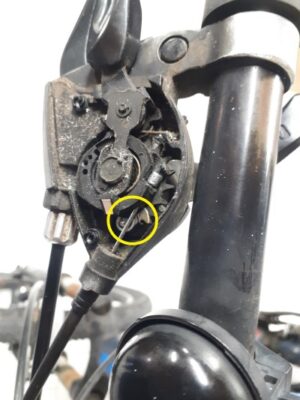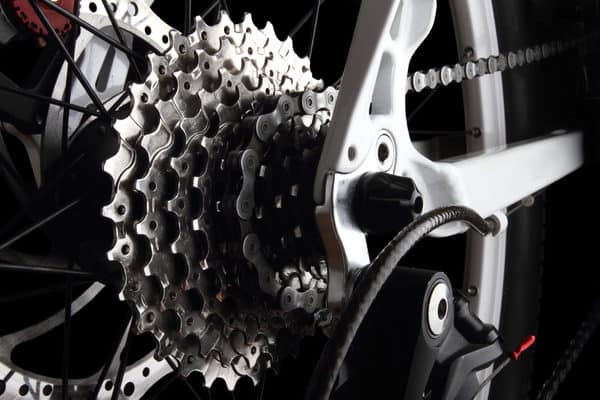Having a stuck shifter is one of the most common maintenance issues on any bicycle. You’ve probably experienced this yourself. It has several reasons why it happens, most of which can be easily prevented or fixed.
You should not waste too much money on this problem by going to bike shops for repairs. Most of them will tell you that parts need to be replaced, while in reality, only a cable and its housing need replacement if they are the problem in the first place. Otherwise, it’s all easy to get working again without a help of a bike shop.
Before I get into the details of how to fix each cause of this problem, we should first analyze what exactly is causing the problem. To not spread the explanations too much apart, I will explain the solution after each analysis. If a certain analysis doesn’t apply to you, skip the solution next to it and go to the next cause.
Why Is My Bicycle Gear Shifter Stuck or Won’t Shift?
Before we find a solution, we should find out which parts are moving and which are not. It’s important to know that even though some parts are moving, that doesn’t mean they are working. To get a precise diagnosis of the problem, it is best to look at how different parts work together.
The Derailleur Is Stuck
I prefer to start from the derailleur because it’s the simplest to analyze. Let’s, for the sake of explanation, say we are talking about a front derailleur. The process and problems are the same for both derailleurs. The first thing to do would be grabbing it with your hands and trying to move it the same way a cable would pull it. If the derailleur is stuck, the shifter will feel like it’s stuck as well.
Limit Screws
If a derailleur has free movement, then everything is fine on that part. The only thing that might need adjusting is the limit screws. If that is causing the problems, the movement will be free but limited to a point in each direction. The feel on the shifter would be that it clicks some gears without any problems but then fails to reach certain gears towards each end.
Solution: Since derailleur adjustment is a topic of its own, I will leave this for another post. In the meantime, you can check youtube for explanations on how to adjust each derailleur.
Rusty Derailleur
If the derailleur is stuck and won’t move at all or the movement is very difficult to the point of using a lot of strength to move it at all, you might have a serious rust problem or perhaps some broken parts.
Solution: Broken parts require replacement, but rust is easily fixed if approx. 10 minutes to the point of derailleur working as new. It would be best if you had a penetrating water displacement spray that has lubricating properties. The most common is WD-40 Multi-use Spray. However, I personally prefer Muc-off MO-94 because when it dries, the surface doesn’t stay too greasy. Once you have your water displacement spray, you need to spray all the joints and moving parts of a derailleur and use your hand to move it forcefully. After you do this for a minute or two, you will see a lot of improvement already. Feel free to spray it some more and continue moving it until the derailleur is moving freely. In most cases, it takes about 3-5 minutes.
Gear Cable Is Stuck or Broken
The next thing to look at is gear cable because it can cause a shifter to feel like it’s stuck, but it actually isn’t. Gear cables can get stuck from rust inside the housing. Also, the shifter and cable could move and normally, but the cable could be broken inside the housing and unable to pull the derailleur. This is rather obvious in most cases, but if the cable housing goes all the way or you have an internal routing frame, you might not notice this at all.
Rusty Shifter Cable
If you are not riding your bike very often or keeping the shifter in the same gear for a long time, cables can start to rust inside the cable housing. They tend to get stuck once there is enough rust. This will cause the feeling similar or even the same as derailleur being stuck by rust. You would push the shifter lever but feel increasing tension until you can’t push it anymore.
Solution: The cable and housing should both be replaced. You can do this by yourself if you know derailleur adjustment. Note that some bikes have a bit complicated internal frame routings and might need some planning to avoid having to route cables from the beginning all over again.
Broken Shifter Cable
Broken cables are rare to see and usually happen because the shifter or derailleur was already stuck, to begin with. In other words, you would most likely notice this immediately and wouldn’t need this article to help you determine the cause. However, if you missed it because of internal routing or the cause of not noticing is that it wasn’t you riding the bike when it happened, you might want to check each end of the cable. If the one next to the shifter is moving when the shifter lever is pushed, yet the other end next to the derailleur isn’t moving, then you have a broken cable.
Solution: The solution would be changing the cable, but you may not need to change the housing unless the cable broke because of rust. Knowledge of derailleur adjustment and, in some cases, internal routing is necessary to repair this on your own.
If you want a quality replacement for your gear cable and housing, use Jagwire Mountain Shop KIT – Shifter/Derailleur Cable & Housing Kit.
Bicycle Gear Shifter Is Stuck or Isn’t Pulling The Cable
I’ve purposefully left all the problems with shifters last because they can be a bit more technical than the first ones regarding derailleurs and cables. Not only that, but problems with derailleurs and cables are a bit more obvious, while shifters sometimes require opening even to see where the problem is.
Stuck Shifter Lever
The shifter lever is stuck. If this is the problem, both shifter levers will be tough to push. This happens with older types of shifters, mostly Shimano ones. Since levers are at the bottom of the shifter, water can pool there either by washing the bike or riding in the rain. The water will wash away any factory grease and cause rust sooner or later. Even if it never gets in contact with water, the grease might dry out if the bike is older, and the same thing happens.
Solution: Most shifters have a bottom plastic cap that you need to take off before reaching levers. However, some older ones have exposed levers with a nut to unscrew them. Taking this apart will be easy, but putting everything back will be quite tricky on some shifters. I would recommend trying WD-40 Multi-use Spray or Muc-off MO-94 and moving levers until they start working again. You can try to unscrew the nut, which holds them just a bit to get them going. If none of this works, then taking them apart and grinding them with sandpaper might be the only option.
Twisted Cable Inside Shifter
Many shifters, even some expensive ones, have some slack on the highest gear in the rear and the lowest in the front. Basically, the cable is a bit loose before you start pushing the lever to switch the gear. That slack on the cable can be pushed and bent inside the shifter. Then, once you try to switch gears on the shifter, it will get stuck.
Solution: You can fix this easily by removing the shifter’s plastic cap and straightening the cable. If it stays bent, you might have a bad shifting afterward, so you want to use pliers to make it as straight as possible. If it’s too far gone, then changing the cable might be a better option. After the cable is straightened out, you may need to tension it slightly to adjust the derailleur with the gears.
Shifter Lever Works But Doesn’t Pull The Cable

You can easily know that this is the case because it will move freely when you push the lever, but it wouldn’t tension the cable or move a derailleur at all. It would be even easier to move the lever than ever before. Sometimes it can alternate between working and not if the pawl is not stuck completely but still has a limited movement.
If you see this happening, don’t let a bike shop convince you that you need a new shifter because you don’t. The fact is most bike shops work with people who ride their bikes at least once a week and always fairly new bikes, so this problem doesn’t happen.
Solution: You should start by opening the shifter’s plastic cap on the top and locating the pawl. It’s not always clearly visible, other parts might cover it, and it’s not always in the same spot, so you need to have a look around. Once you’ve located it, you can use WD-40 Multi-use Spray or Muc-off MO-94 to loosen it up. I wouldn’t recommend forcefully moving it with some tool to prevent damaging the spring. It’s better to let it work itself out by shifting a dozen times. Since water displacement sprays dry out quickly, for a long-term solution, I prefer putting a drop of chain lube on it at the end.
You can most of the time avoid having to open the shifter and spray water displacement inside through any gap. However, in this case, you need to soak it real good to reach the pawl, and you might have an oily substance dripping out for days which can get messy when you are riding the bike.
Preventing Bicycle’s Moving Parts From Getting Stuck
I can’t stress enough how important it is to prevent these kinds of problems. Especially when preventing them is so easy to do. It takes once a year lubricating all moving parts like derailleurs, cables, and shifters. Watch out not to lubricate the brakes or bearings as they need different care.
I believe I saved huge amounts of money for my customers over the years by fixing bikes this way, instead of replacing the parts as most do.

